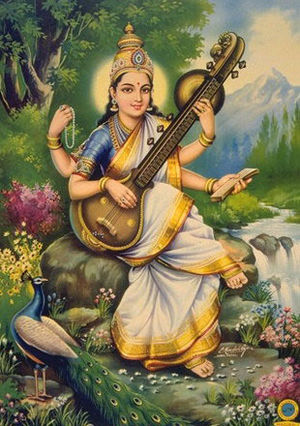Сарасвати


Божественная Мать в лице Сарасвати является шакти Брахмы. В индуистской Троице Брахма известен как Творец, что соответствует ипостаси Бога-Отца в западной Троице. Он — Божественный Законодатель, источник всего знания. Вместе Брахма и Сарасвати являются воплощением космической силы.
Attributes
Sarasvati is known as the Goddess of the Word. She is identified with Vac, the Word. She represents eloquence and articulates the wisdom of the Law. She is the Mother-Teacher to those of us who love the Law revealed by Brahma, and she is the power of volition, the will and motivation to be the Law in action. Sarasvati represents the union of power and intelligence from which organized creation arises.
In the book Symbolism in Hinduism, A. Parthasarathy notes that the name Sarasvati literally means “the one who gives the essence of our own Self.” Sarasvati is sometimes represented with four hands, sitting on a lotus. She holds the sacred scriptures in one hand and a lotus in another. With the remaining two hands, she plays the Indian lute (veena).[1]
Parthasarathy writes: “The Goddess, therefore, represents the ideal guru.... ‘Sitting on the lotus’ symbolises that the teacher is well established in the subjective experience of the Truth. ‘Holding the Scriptures in her hand’ indicates that she upholds that the knowledge of the Scriptures alone can take us to the Truth." Parthasarathy says that Sarasvati’s playing of the lute suggests “that a truly qualified teacher tunes up the mind and intellect of the seeker and draws out of him the music and melody of life.”[2]
According to scholar David Frawley, in an esoteric sense Sarasvati “represents the stream of wisdom, the free flow of the knowledge of consciousness.”[3] She is called the Flowing One, the source of creation by the Word.
Sarasvati also represents purity and wears white. David Kinsley, Professor of Religious Studies at McMaster University in Ontario, Canada, explains:
The predominant themes in Sarasvati’s appearance are purity and transcendence. She is almost always said to be pure white like snow, the moon, or the kunda flower.... Her garments are said to be fiery in their purity....
Sarasvati’s transcendent nature ... is also suggested in her vehicle, the swan. The swan is a symbol of spiritual transcendence and perfection in Hinduism.... Sarasvati, astride her swan, suggests a dimension of human existence that rises above the physical, natural world. Her realm is one of beauty, perfection, and grace; it is a realm created by artistic inspiration, philosophic insight, and accumulated knowledge, which have enabled human beings to so refine their natural world that they have been able to transcend its limitations. Sarasvati astride her swan beckons human beings to continued cultural creation and civilized perfection.... She not only underlies the world and is its creator but is the [very] means to transcend the world.[4]
Sarasvati is associated with speech, poetry, music and culture and is known as the Goddess of Learning and the Patroness of the Arts and Music. She is revered by both Hindus and Buddhists. To Buddhists, she is the consort of Manjushri, the bodhisattva of wisdom. Buddhists appeal to Manjushri for intelligence, wisdom, mastery of the teaching, the power of exposition, eloquence and memory. He works with Lord Maitreya. The two are sometimes depicted in a triad with Gautama Buddha in which Manjushri represents the wisdom aspect and Maitreya the compassion aspect of Buddhist teaching. Like Sarasvati, Manjushri brings the gift of illumination.
The river Sarasvati
In the earliest Hindu texts, the Vedas, Sarasvati is a river goddess. The Vedas say that Sarasvati was the greatest river in India. For years the Sarasvati was believed to have been a myth, but an archaeological survey in 1985 found an ancient riverbed that matched the description of the Sarasvati. It was a great river, four to six miles wide for much of its length. It flowed westward from the Himalayas into the sea. Frawley believes that the Sarasvati was the main site of habitation at the time the Vedas were composed thousands of years ago.[5]
Frawley says that the Sarasvati, “like the later Ganges, symbolizes the Sushumna, the river of spiritual knowledge, the current that flows [through the spinal canal] through the seven chakras of the subtle body. She is not only the Milky Way or river of Heaven, inwardly she is the river of true consciousness that flows into this world.”[6]
The Rigveda calls Sarasvati “the best mother, the best river, [and] the best Goddess.”[7] It also says, “Sarasvati like a great ocean appears with her ray, she rules all inspirations.”[8]
Her sacred “seed syllable,” or bija, is Aim (pronounced ah-eem). A bija mantra encapsulates the essence of a cosmic being, of a principle or a chakra. Sarasvati’s mantra is Om Aim Sarasvatye Namaha.
See also
Sources
Mark L. Prophet and Elizabeth Clare Prophet, The Masters and Their Retreats, s.v. “Sarasvati, Shakti of Brahma.”
- ↑ A. Parthasarathy, “Consorts of the Three Gods,” in R. S. Nathan, comp., Symbolism in Hinduism (Bombay: Central Chinmaya Mission Trust, 1989), p. 157.
- ↑ Ibid., pp. 157–58.
- ↑ David Frawley, From the River of Heaven: Hindu and Vedic Knowledge for the Modern Age (Sandy, Utah: Morson Publishing, 1990), p. 126.
- ↑ David Kinsley, Hindu Goddesses: Visions of the Divine Feminine in the Hindu Religious Tradition (Berkeley, Calif.: University of California Press, 1986), pp. 62, 141.
- ↑ David Frawley, Gods, Sages and Kings: Vedic Secrets of Ancient Civilization (Salt Lake City, Utah: Passage Press, 1991), pp. 72–76, 354–57 nn. d–g.
- ↑ Ibid., p. 219.
- ↑ Rigveda 2.41.16, 1.3.12, quoted in Frawley, Gods, Sages and Kings, pp. 70, 71.
- ↑ Sri-sukta 1, 6, 13, 4, in Rigveda, cited by David Kinsley, The Goddesses’ Mirror: Visions of the Divine from East and West (Albany, N.Y.: State University of New York Press, 1989), p. 55.
